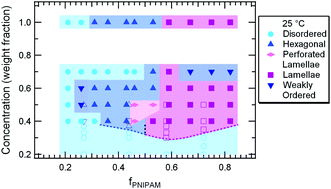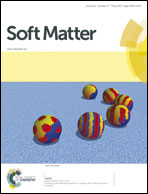Coil fraction-dependent phase behaviour of a model globular protein–polymer diblock copolymer†
Abstract
The self-assembly of the model globular protein–polymer block copolymer mCherry-b-poly(N-isopropyl acrylamide) is explored across a range of polymer coil fractions from 0.21 to 0.82 to produce a phase diagram for these materials as a function of molecular composition. Overall, four types of morphologies were observed: hexagonally packed cylinders, perforated lamellae, lamellae, and disordered nanostructures. Across all coil fractions and morphologies, a lyotropic re-entrant order–disorder transition in water was observed, with disordered structures below 30 wt% and above 70 wt% and well-ordered morphologies at intermediate concentrations. Solid state samples prepared by solvent evaporation show moderately ordered structures similar to those observed in 60 wt% solutions, suggesting that bulk structures result from kinetic trapping of morphologies which appear at lower concentrations. While highly ordered cylindrical nanostructures are observed around a bioconjugate polymer volume fraction of 0.3 and well-ordered lamellae are seen near a volume fraction of 0.6, materials at lower or higher coil fractions become increasingly disordered. Notable differences between the phase behaviour of globular protein–polymer block copolymers and coil–coil diblock copolymers include the lack of spherical nanostructures at either high or low polymer coil fractions as well as shifted phase boundaries between morphologies which result in an asymmetric phase diagram.


 Please wait while we load your content...
Please wait while we load your content...